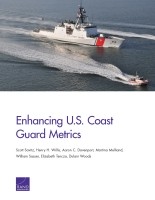| 来源类型 | Research Reports
|
| 规范类型 | 报告
|
| ISBN | 9780833091567
|
| 来源ID | RR-1173-USCG
|
| Enhancing U.S. Coast Guard Metrics |
| Scott Savitz; Henry H. Willis; Aaron C. Davenport; Martina Melliand; William Sasser; Elizabeth Tencza; Dulani Woods
|
| 发表日期 | 2015
|
| 出版年 | 2015
|
| 页码 | 200
|
| 语种 | 英语
|
| 结论 |
This Research Produced a Series of Logic Models Describing Coast Guard Missions- Using Coast Guard documentation and discussions with subject-matter experts, the authors developed logic models that describe each of the service's 11 statutory missions in detail. These logic models include the outcomes, accomplishments, and activities (collectively termed "elements") associated with each mission, as well as relationships among them.
- The elements of these logic models suggest suitable areas for performance measurement.
Existing Metrics Do Not Capture All the Elements of These Models- Existing metrics capture only 29 percent of the elements of the logic models.
- Of the existing metrics, 48 percent have high validity, 74 percent have high reliability, and 82 percent have high feasibility; only 34 percent rate highly on all three criteria.
The Authors Developed a Menu of Potential Additional Performance Measures Addressing All Elements of the Models- The potential measures either cover unaddressed elements or offer higher levels of validity, reliability, and/or feasibility than existing metrics.
- These measures are grouped by mission and aligned with specific elements of the logic models.
- The Coast Guard can select the potential measures that address its most critical operational issues.
The Authors Developed a Framework for Applying Metrics to Make Decisions- By using a structured framework, the Coast Guard can use metrics more effectively to aid operational-level decisions.
|
| 摘要 |
- The logic models offer a means for the Coast Guard to assess what it needs to measure with respect to each mission.
- The service can select from among existing and proposed metrics to find those that are most suitable for addressing operational questions and making decisions.
- The metrics will need to be evaluated to determine appropriate values for individual metrics and relationships among metrics.
- The Coast Guard can also coordinate with other components of the Department of Homeland Security, as well as with the Department of Defense, National Oceanic and Atmospheric Administration, Environmental Protection Agency, Drug Enforcement Agency, and other agencies, to align operational metrics in a way that facilitates communication and decisionmaking.
- The Coast Guard can use a structured framework to facilitate the use of metrics in making operational-level decisions.
|
| 主题 | Modeling and Simulation
; Performance Measurement
; United States Coast Guard
|
| URL | https://www.rand.org/pubs/research_reports/RR1173.html
|
| 来源智库 | RAND Corporation (United States)
|
| 资源类型 | 智库出版物
|
| 条目标识符 | http://119.78.100.153/handle/2XGU8XDN/107991
|
推荐引用方式
GB/T 7714 |
Scott Savitz,Henry H. Willis,Aaron C. Davenport,et al. Enhancing U.S. Coast Guard Metrics. 2015.
|
|
文件名:
|
x1495316227024.jpg
|
|
格式:
|
JPEG
|

|
文件名:
|
RAND_RR1173.pdf
|
|
格式:
|
Adobe PDF
|
除非特别说明,本系统中所有内容都受版权保护,并保留所有权利。